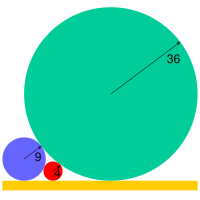
Sangaku or san gaku (Japanese: 算額, lit. 'calculation tablet') are Japanese geometrical problems or theorems on wooden tablets which were placed as offerings at Shinto shrines or Buddhist temples during the Edo period by members of all social classes.
History

The sangaku were painted in color on wooden tablets (ema) and hung in the precincts of Buddhist temples and Shinto shrines as offerings to the kami and buddhas, as challenges to the congregants, or as displays of the solutions to questions. Many of these tablets were lost during the period of modernization that followed the Edo period, but around nine hundred are known to remain.
Fujita Kagen (1765–1821), a Japanese mathematician of prominence, published the first collection of sangaku problems, his Shimpeki Sampo (Mathematical problems Suspended from the Temple) in 1790, and in 1806 a sequel, the Zoku Shimpeki Sampo.
During this period Japan applied strict regulations to commerce and foreign relations for western countries so the tablets were created using Japanese mathematics, developed in parallel to western mathematics. For example, the connection between an integral and its derivative (the fundamental theorem of calculus) was unknown, so sangaku problems on areas and volumes were solved by expansions in infinite series and term-by-term calculation.
Select examples

| rmiddle | rleft | rright |
|---|---|---|
| 1 | 4 | 4 |
| 4 | 9 | 36 |
| 9 | 16 | 144 |
| 16 | 25 | 400 |
| 72 | 200 | 450 |
| 144 | 441 | 784 |
| The six primitive triplets of integer radii up to 1000 | ||
- A typical problem, which is presented on an 1824 tablet in Gunma Prefecture, covers the relationship of three touching circles with a common tangent, a special case of Descartes' theorem. Given the size of the two outer large circles, what is the size of the small circle between them? The answer is:
(See also Ford circle.)
- Soddy's hexlet, thought previously to have been discovered in the west in 1937, had been discovered on a sangaku dating from 1822.
- One sangaku problem from Sawa Masayoshi and other from Jihei Morikawa were solved only recently.
See also
- Equal incircles theorem
- Japanese theorem for concyclic polygons
- Japanese theorem for concyclic quadrilaterals
- Problem of Apollonius
- Recreational mathematics
- Seki Takakazu
Notes
- Holly, Jan E.; Krumm, David (2020-07-25). "Morikawa's Unsolved Problem". arXiv:2008.00922 .
- Kinoshita, Hiroshi (2018). "An Unsolved Problem in the Yamaguchi's Travell Diary" (PDF). Sangaku Journal of Mathematics. 2: 43–53.
References
- Fukagawa, Hidetoshi, and Dan Pedoe. (1989). Japanese temple geometry problems = Sangaku. Winnipeg: Charles Babbage. ISBN 9780919611214; OCLC 474564475
- __________ and Dan Pedoe. (1991) How to resolve Japanese temple geometry problems? (日本の幾何ー何題解けますか?, Nihon no kika nan dai tokemasu ka) Tōkyō : Mori Kitashuppan. ISBN 9784627015302; OCLC 47500620
- __________ and Tony Rothman. (2008). Sacred Mathematics: Japanese Temple Geometry. Princeton: Princeton University Press. ISBN 069112745X; OCLC 181142099
- Huvent, Géry. (2008). Sangaku. Le mystère des énigmes géométriques japonaises. Paris: Dunod. ISBN 9782100520305; OCLC 470626755
- Rehmeyer, Julie, "Sacred Geometry", Science News, March 21, 2008.
- Rothman, Tony; Fugakawa, Hidetoshi (May 1998). "Japanese Temple Geometry". Scientific American. pp. 84–91.
External links
- Sangaku (Japanese votive tablets featuring mathematical puzzles)
- Japanese Temple Geometry Problem
- Sangaku: Reflections on the Phenomenon
- Sangaku Journal of Mathematics
